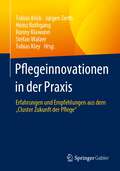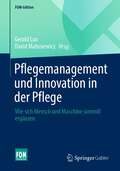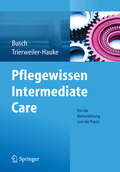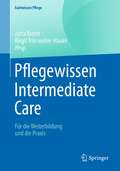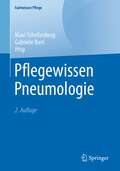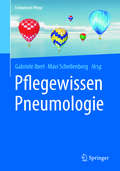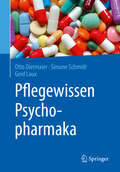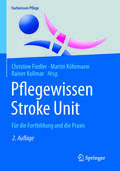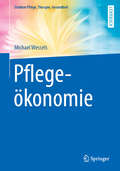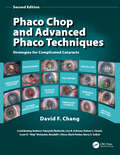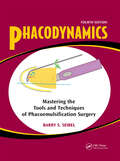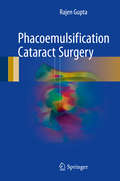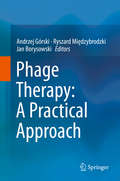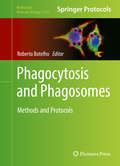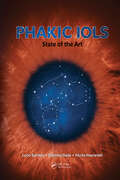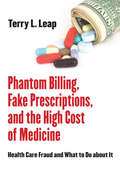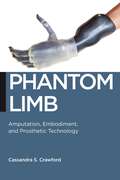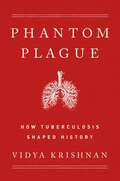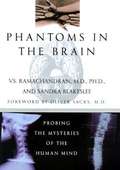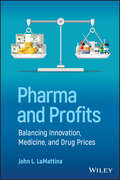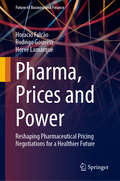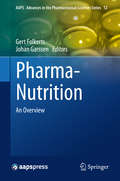- Table View
- List View
Pflegeinnovationen in der Praxis: Erfahrungen und Empfehlungen aus dem „Cluster Zukunft der Pflege“
by Heinz Rothgang Stefan Walzer Tobias Krick Jürgen Zerth Ronny Klawunn Tobias KleyPflegeinnovationen - insbesondere in Verbindung mit Digitalisierung und den Potenzialen von KI - werden als wesentlicher Hebel gesehen, um sowohl die Qualität in der Pflege anzuheben als auch den wachsenden Herausforderungen des Fachkräftemangels zu begegnen. Die Frage, welche Faktoren die Entwicklung, Auswahl und Implementierung von Pflegetechnologien befördern oder auch behindern können, ist die Aufgabe des vom Bundesministerium für Bildung und Forschung (BMBF) geförderten „Cluster Zukunft der Pflege“. Dabei wird das gesamte soziotechnische System Pflege (Mensch, Organisation und Technik), in dem die Technik zum Einsatz kommen soll, betrachtet.An Beispielen aus dem Pflegeinnovationszentrum (PIZ) und aus vier Pflegepraxiszentren (PPZ) werden in diesem Buch die Phasen des Technologieentwicklungsprozesses und der Implementierung von Pflegeinnovationen in diversen pflegerischen Settings des praktischen Pflegealltags vorgestellt, die Fragen nach sozialer, ethischer und ökonomischer Relevanz sowie die Bedeutung des praktischen Nutzens sowie der Akzeptanz gestellt und diskutiert. Zugleich werden Bedingungsfaktoren für gelingende Pflegeinnovationen analysiert, damit sich der pflegerische Nutzen der Pflegebedürftigen und der Nutzen der Pflegenden verbessern lassen. Kurz: Ein profunder Einblick in die Werkstatt „Zukunft der Pflege“ mit zahlreichen praxisorientieren Erkenntnissen für den Einsatz von digitalen Innovationen im Pflegealltag und Hinweisen für den weiteren Entwicklungs- und Forschungsbedarf.
Pflegemanagement und Innovation in der Pflege: Wie sich Mensch und Maschine sinnvoll ergänzen (FOM-Edition)
by David Matusiewicz Gerald LuxDie Pflegebranche in Deutschland ist im Umbruch – sie muss dem zunehmenden Fachkräftemangel etwas entgegensetzen und zugleich als eine der Zukunftsbranchen die Potenziale der Technisierung und Digitalisierung heben.Dieses Buch erfasst und analysiert die derzeitigen Trends und Herausforderungen sowohl im Bereich der praktischen Pflege als auch auf der Ebene des Pflegemanagements auf allen Führungsebenen. Die Autoren der 30 wissenschaftlichen Beiträge zeigen, wie politische Entscheider, die Organe der Selbstverwaltung und die einzelnen Unternehmen durch unterschiedliche Maßnahmen den Problemen der Pflegebranche entgegenwirken können. Es werden eine Reihe von Handlungsmöglichkeiten und Entwicklungsperspektiven für die unterschiedlichen Akteure der Pflegebranche aufgezeigt, bei denen sich der Faktor Mensch und der Faktor Maschine sinnvoll ergänzen können. Auch werden Pflegekonzepte mit in den Blick genommen, die bisher weniger bekannt sind. Ebenso werden innovative Ansätze von Start-ups und sozialen Entrepreneuren in der Pflege präsentiert.Nicht zuletzt die Corona-Pandemie hat gezeigt, dass die Pflege eine zentrale, systemrelevante Stütze im Gesundheitswesen in Deutschland darstellt. Die jüngsten Reformen in der Pflegepolitik sind Ausdruck davon und zeigen, dass sich Entscheider auf allen Ebenen und in allen Bereichen der Pflege mit den drängenden Fragen auseinandersetzen müssen. Dazu liefert dieses Buch wichtige Impulse und Anregungen.
Pflegeroboter
by Oliver BendelDieses Open-Access-Buch bündelt technische, wirtschaftliche, medizinische und ethische Reflexionen über Pflegeroboter. Pflegeroboter, im Moment noch mehrheitlich Prototypen, unterstützen oder ersetzen menschliche Pflegekräfte bzw. Betreuer. Sie bringen Kranken und Alten die benötigten Medikamente und Nahrungsmittel, helfen beim Hinlegen und Aufrichten oder alarmieren den Notdienst. Vorteile von Pflegerobotern sind durchgehende Verwendbarkeit und gleichbleibende Qualität der Dienstleistung. Nachteile sind Kostenintensität (bei möglicher Amortisation) und Komplexität der Anforderungen. Unter der wissenschaftlichen Leitung von Prof. Dr. Oliver Bendel trafen sich im September 2017 Vertreter verschiedener wissenschaftlicher Disziplinen im Rahmen eines Ladenburger Diskurses der Daimler und Benz Stiftung, um über den aktuellen und künftigen Einsatz von Pflegerobotern zu sprechen und Forschungspotenziale zu identifizieren. Die Autoren gehen in ihren Beiträgen auch Fragen aus Wirtschafts-, Medizin- und Informationsethik nach: Wer trägt die Verantwortung bei einer fehlerhaften Betreuung und Versorgung durch die Maschine? Inwieweit kann diese die persönliche und informationelle Autonomie des Patienten unterstützen oder gefährden? Ist der Roboter eine Entlastung oder ein Konkurrent für Pflegekräfte? Antworten müssen von Wissenschaft und Gesellschaft gefunden werden.
Pflegewissen Intermediate Care: Für die Weiterbildung und die Praxis
by Jutta Busch Birgit Trierweiler-HaukeFür das erste Fachbuch zur Pflege auf Intermediate Care-Stationen hat das multiprofessionelle Autoren-Team das Grundwissen zu den intensivpflegerischen Aufgaben lerngerecht aufbereitet: mit Fallbeispielen und Wissensfragen. Der umfangreiche Anleitungsteil bietet Musterformulare für die Vorbereitung, Durchführung und Auswertung von Praxiseinsätzen während der Weiterbildung. Der Band ist als Lehrbuch für die Teilnehmer einer IMC-Qualifizierung bestens geeignet und orientiert sich an den Empfehlungen der Deutschen Gesellschaft für Fachkrankenpflege.
Pflegewissen Intermediate Care: Für die Weiterbildung und die Praxis (Fachwissen Pflege)
by Jutta Busch Birgit Trierweiler-HaukeDas Lehrbuch für die Weiterbildung und darüber hinaus!Dieses Fachbuch bietet Pflegenden aus dem Bereich Intermediate Care (IMC) kompaktes Grundlagenwissen und zeigt dessen erfolgreiche Umsetzung anhand zahlreicher Beispiele aus dem Praxisalltag. Durch die Darstellung konkreter Fälle mit unterschiedlichen Erkrankungen werden die pflegerischen Aufgaben und besonderen Herausforderungen nachvollziehbar dargestellt. Profitieren Sie vom Erfahrungsschatz der Autoren und lesen Sie die zahlreichen Tipps und Anregungen, auch für die gelungene Anleitung neuer Mitarbeiter! Die übersichtliche Struktur ermöglicht Ihnen einen schnellen Zugang zu allen wichtigen Inhalten. Für einen optimalen Einstieg auf die IMC-Station!
Pflegewissen Pneumologie (Fachwissen Pflege)
by Gabriele Iberl Mavi SchellenbergPneumologie im Wandel – Pflege auf dem neusten Stand!Dieses Buch bietet Pflegenden auf pneumologischen Stationen und Einrichtungen spezielles Fachwissen für die kompetente und umfassende Versorgung ihrer Patienten.Die Durchführung von allgemeinen und speziellen Pflegemaßnahmen bei der Betreuung von Menschen mit akuten und chronischen Atemwegserkrankungen erfordert besondere fachliche und psychosoziale Fähigkeiten. Besonders in der Pandemie wurde dies nochmal deutlich. Lernen Sie anhand konkreter Fallbeispiele, wie Sie theoretische Grundlagen in der Praxis effektiv umsetzen können. Das interdisziplinäre Autorenteam macht deutlich, dass die pflegerischen Aufgaben bei der Behandlung einen wesentlichen Teil einnehmen und das Outcome der Patienten positiv beeinflussen.
Pflegewissen Pneumologie (Fachwissen Pflege)
by Gabriele Iberl and Mavi SchellenbergFachwissen für die spezielle Pflege pneumologischer Patienten!Dieses Buch bietet Pflegenden auf pneumologischen Stationen und Einrichtungen spezielles Fachwissen für die kompetente und umfassende Versorgung ihrer Patienten. Die Durchführung von allgemeinen und speziellen Pflegemaßnahmen bei der Betreuung von Menschen mit akuten und chronischen Atemwegserkrankungen erfordert besondere fachliche und psychosoziale Fähigkeiten. Lernen Sie anhand konkreter Fallbeispiele, wie Sie theoretische Grundlagen in der Praxis effektiv umsetzen können. Das interdisziplinäre Autorenteam macht deutlich, dass die pflegerischen Aufgaben bei der Behandlung einen wesentlichen Teil einnehmen und das Outcome der Patienten positiv beeinflussen.
Pflegewissen Psychopharmaka
by Simone Schmidt Otto Dietmaier Gerd LauxMehr als nur Aufbewahren, Richten und Verabreichen: verantwortungsvoll Pflegen!Dieses Buch richtet sich an Pflegende im ambulanten und stationären Bereich und bietet wichtiges Fachwissen über Psychopharmaka. Welches sind die wesentlichen Merkmale der einzelnen Medikamentengruppen? Was sind die Wirkmechanismen, Neben- und Wechselwirkungen und wie geht man therapeutisch vor? Hier benötigen Pflegende eine gute Basiskompetenz, denn es bestehen viele Vorurteile und Halbwahrheiten gegenüber den am meisten verordneten Medikamenten. Kontinuierliche Krankenbeobachtung und eine frühzeitige Informationsweitergabe gehören ebenso zu der Verantwortung, wie das korrekte Aufbewahren, Richten und Verabreichen. Die einheitliche Struktur des Buches bietet eine gute Übersicht der unterschiedlichen Gruppen und pflegerischen Besonderheiten.
Pflegewissen Stroke Unit: Für die Fortbildung und die Praxis (Fachwissen Pflege)
by Christine Fiedler Martin Köhrmann Rainer KollmarDas Konzept der Stroke Unit zielt auf die Akutbehandlung von Schlaganfallpatienten und eine rasche, strukturierte Sekund#65533;rprophylaxe ab. Ein Autorenteam aus Fachpflegern, Therapeuten, #65533;rzten und Neuropsychologen vermittelt die daf#65533;r erforderlichen Spezialkenntnisse - verst#65533;ndlich und praxisnah: von Diagnoseverfahren und Behandlungsans#65533;tzen #65533;ber bew#65533;hrte Therapien bis hin zu Fragen der Ern#65533;hrung, der Kommunikation und des Qualit#65533;tsmanagements. Das Lehrbuch orientiert sich an der Fachweiterbildung ,,Stroke Unit" der Deutschen Schlaganfall-Gesellschaft.
Pflegeökonomie (Studium Pflege, Therapie, Gesundheit)
by Michael WesselsPflege und Ökonomie – Ein Widerspruch, der keiner ist!Dieses Buch erklärt Pflegenden, Pädagogen und Studierenden im Gesundheitswesen die Zusammenhänge zwischen Pflege und Ökonomie. Dabei werden Gegenstand und Ziele verständlich erläutert und so etwaigen Berührungsängsten entgegengewirkt. Der erfahrene Autor zeigt wie Wissen aus der Ökonomie und Erkenntnisse der Pflegewissenschaft miteinander verknüpft sind. Dabei dreht es sich immer darum die Versorgung der Pflegebedürftigen sicherzustellen und Verschwendung zu vermeiden.
Phaco Chop and Advanced Phaco Techniques: Strategies for Complicated Cataracts
by David F. ChangWhile chopping techniques are particularly advantageous for complicated cataracts, they must be integrated with other devices and strategies. Phaco Chop, the best-selling cataract surgery book, has been revised and updated into a Second Edition to reflect the many advances over the past few years. More than half of the 30 total chapters are new. These detail strategies for complicated cases and introduce femtosecond laser nuclear fragmentation techniques.Dr. David F. Chang is widely acknowledged as one of the best cataract surgical teachers. His video instruction courses for phaco chop and complicated cataracts have consistently ranked among the best attended and top rated at the American Academy of Ophthalmology and American Society of Cataract and Refractive Surgeons meetings for over a decade.The Four Main Sections inside the Second Edition: Phaco Chop Techniques Phacodynamics of Chopping Femtosecond Laser Nuclear Pre-Chopping Complicated Cases and Complications – Strategies and Management Section One is a detailed guide for learning phaco chop. The faculty from Dr. Chang’s popular phaco chop course outlines their pearls based upon extensive experience teaching residents and transitioning surgeons.Section Two provides the general principles of instrumentation and configuring machine parameters. Separate chapters specifically address optimizing the Infiniti, Signature, and Stellaris platforms for chopping.Section Three introduces femtosecond laser nuclear pre chopping with separate chapters on the LenSx, LensAR, and Optimedica platforms.Section Four covers small pupils and IFIS, rock hard and white mature cataracts, weak zonules, and extremely long and short eyes with an emphasis on managing posterior capsule rupture, advanced IOL fixation strategies, and avoiding and managing capsulorrhexis complications.Bonus Video Material!Phaco Chop and Advanced Phaco Techniques, Second Edition includes instructional video that complements and supplements the content of the book.With your book purchase, you will receive a DVD that contains 26 surgical videos in high definition 3D format. With the enclosed 3D glasses—learning intraocular surgical techniques is taken to a new level.Additionally, you will receive access to a website that includes additional companion surgical videos narrated by Dr. Chang in 2D format—watch, listen, view repeatedly, and learn the techniques!The narrated videos produced by Dr. Chang illustrate advanced surgical techniques and technologies. Together with over 400 high-resolution operative photographs, this paired format overcomes the limitations of learning new and advanced surgical techniques from written text alone.With its comprehensive and integrated emphasis on advanced surgical techniques, optimizing phaco technology, and complication management, Phaco Chop and Advanced Phaco Techniques: Strategies for Complicated Cataracts, Second Edition will appeal to residents and transitioning surgeons as well as high volume surgeons interested in honing their most advanced phaco skills.
Phacodynamics: Mastering the Tools and Techniques of Phacoemulsification Surgery
by Barry S. SeibelWhat surgical advancements have spawned from the evolution of phaco technology? Join the thousands of surgeons who have utilized Phacodynamics: Mastering the Tools and Techniques of Phacoemulsification Surgery to understand and benefit from the advantages of phaco technology. The revised, expanded, and updated Fourth Edition of this classic text includes over 300 simple, yet elegant, figures and illustrations detailing the latest machine technologies and surgical techniques. Visual learners…In addition to examining the intricate relationship between the surgeon and the phaco machine, Dr. Barry Seibel profiles how the most recent advancements in machine technology can enhance your surgical procedures and optimize your results. With schematic figures and illustrations to accompany the detailed descriptions, surgeons can readily identify and distinguish between various flow pumps, vacuum pumps, and ultrasound power modulations. Surgery can then be customized moment by moment for each individual patient to maximize safety and efficacy.Phacodynamics, Fourth Edition utilizes a simplified approach to explain all the latest advancements in phaco technology and surgery and should be in the hands of all surgeons practicing in this specialized area.New topics included that are unique to this Fourth Edition:Bimanual Microincision Phaco Ultrasound Power Modulations including Burst and Pulse Modes AquaLase and Laser Surgical Technologies Expanded Horizontal Chopping Techniques including PreChop Vertical Chopping Techniques and Instrumentation Bimanual Irrigation and Aspiration Phacodynamic Complications Phacodynamics of Surgical Instrument Design
Phacoemulsification Cataract Surgery
by Rajen GuptaThis book provides ophthalmic surgeons with a concise, clinical guide to performing the fundamentals steps in phacoemulsification cataract surgery. Clear diagrams and images are used throughout and the information can be adapted to a particular consultant's own technique once the surgical principles are understood. The chapters serve as a modular framework that allows for safe, effective learning of skills and use as a clinical training resource. Phacoemulsification Cataract Surgery serves as a helpful teaching aid for consultants, especially newly appointed, who have little experience in teaching. Basic fundamental rules are provided as a guide for training others to improve surgical techniques in clinical practice. Recently qualified and experienced consultants will find this book to be an indispensable resource for learning and teaching in the area of phacoemulsification cataract surgery.
Phage Display In Biotechnology and Drug Discovery (Drug Discovery Series)
by Sachdev S. Sidhu Clarence Ronald GeyerPhage Display in Biotechnology and Drug Discovery, Second Edition provides a comprehensive view of the impact and promise of phage display in drug discovery and biotechnology. Building on the success of its previous edition, the book discusses current theories, principles, and methods in the field and demonstrates applications for peptide phage dis
Phage Therapy: A Practical Approach
by Andrzej Górski Ryszard Międzybrodzki Jan BorysowskiThis book gives a detailed yet clear insight into the current state of the art of the therapeutic application of bacteriophages in different conditions. The authors bring in their practical expertise within their respective fields of expertise and provide an excellent overview of the potential and actual use of phage therapy. Topics like economic feasibility compared to traditional antibiotics and also regulatory issues are discussed in far detail. This new volume is therefore a valuable resource for individuals engaged in the medical application of novel phage therapies.
Phagocytosis and Phagosomes
by Roberto BotelhoThis volume details experimental approaches used to investigate phagocytosis and phagosome maturation. Chapters present methods and protocols on quantifying uptake and phagosome maturation using biophysical and biochemical approaches, proteomics, microscopy, and flow cytometry. Written in the highly successful Methods in Molecular Biology series format, chapters include introductions to their respective topics, lists of the necessary materials and reagents, step-by-step, readily reproducible laboratory protocols, and tips on troubleshooting and avoiding known pitfalls. Authoritative and cutting-edge, Phagocytosis and Phagosomes: Methods and Protocols aims to be an important resource for both experts in the field and for those investigators delving into phagocytosis and phagosome maturation for the first time.
Phakic IOLs: State of the Art
by Lucio Buratto Stephen Slade Nicola HauraniehThe surgical correction of refractive vision errors has dramatically and continually changed over time. The evolution of laser vision correction has been aided by advancements in the technology, growing experience, and improved understanding of the eye and its response to surgery. However, not all refractive errors can be treated with the laser. Phakic IOLs: State of the Art is designed to provide the advances in phakic IOL technology and techniques, ideal for physicians who treat many of the patients who are not candidates for laser vision correction. The collaboration of Dr. Lucio Buratto, Dr. Stephen G. Slade, and Dr. Nicola D. Hauranieh, along with a team of international surgeons, has produced a complete book specifically aimed to improve the treatment and therefore the quality of vision of patients. Phakic IOLs: State of the Art is designed for ophthalmologists interested in learning the concepts, developing the skills, and preparing for phakic IOL procedures. This book contains a detailed description of the basic technique of the operations, as well as the special techniques devised by the international contributors. Richly illustrated with over 200 images that demonstrate the various concepts, readers are able to develop a more thorough understanding of phakic IOL implantation. This definitive resource couples both the authors’ and contributors’ diverse experience and knowledge to produce a complete resource of vision correction with phakic IOLs.Expert ophthalmologists interested in being on the cutting edge and enhancing their surgical skills, as well as new physicians, will benefit from adding Phakic IOLs: State of the Art to their personal library.
Phantom Billing, Fake Prescriptions, and the High Cost of Medicine: Health Care Fraud and What to Do about It (The Culture and Politics of Health Care Work)
by Terry L. LeapU.S. health care is a $2.5 trillion system that accounts for more than 17 percent of the nation’s GDP. It is also highly susceptible to fraud. Estimates vary, but some observers believe that as much as 10 percent of all medical billing involves some type of fraud. In 2009, New York’s Medicaid fraud office recovered $283 million and obtained 148 criminal convictions. In July 2010, the U.S. Justice Department charged nearly 100 patients, doctors, and health care executives in five states of bilking the Medicare system out of more than $251 million through false claims for services that were medically unnecessary or never provided. These cases only hint at the scope of the problem.In Phantom Billing, Fake Prescriptions, and the High Cost of Medicine, Terry L. Leap takes on medical fraud and its economic, psychological, and social costs. Illustrated throughout with dozens of specific and often fascinating cases, this book covers a wide variety of crimes: kickbacks, illicit referrals, overcharging and double billing, upcoding, unbundling, rent-a-patient and pill-mill schemes, insurance scams, short-pilling, off-label marketing of pharmaceuticals, and rebate fraud, as well as criminal acts that enable this fraud (mail and wire fraud, conspiracy, and money laundering). After assessing the effectiveness of the federal laws designed to fight health care fraud and abuse—the antikickback statute, the Stark Law, the False Claims Act, HIPAA, and the food and drug laws—Leap suggests a number of ways that health care providers, consumers, insurers, and federal and state officials can bring health care fraud and abuse under control, thereby reducing the overall cost of medical care in America.
Phantom Limb: Amputation, Embodiment, and Prosthetic Technology (Biopolitics #16)
by Cassandra S. CrawfordPhantom limb pain is one of the most intractable and merciless pains ever known—a pain that haunts appendages that do not physically exist, often persisting with uncanny realness long after fleshy limbs have been traumatically, surgically, or congenitally lost. The very existence and “naturalness” of this pain has been instrumental in modern science’s ability to create prosthetic technologies that many feel have transformative, self-actualizing, and even transcendent power. In Phantom Limb, Cassandra S. Crawford critically examines phantom limb pain and its relationship to prosthetic innovation, tracing the major shifts in knowledge of the causes and characteristics of the phenomenon. Crawford exposes how the meanings of phantom limb pain have been influenced by developments in prosthetic science and ideas about the extraordinary power of these technologies to liberate and fundamentally alter the human body, mind, and spirit. Through intensive observation at a prosthetic clinic, interviews with key researchers and clinicians, and an analysis of historical and contemporary psychological and medical literature, she examines the modernization of amputation and exposes how medical understanding about phantom limbs has changed from the late-19th to the early-21st century. Crawford interrogates the impact of advances in technology, medicine, psychology and neuroscience, as well as changes in the meaning of limb loss, popular representations of amputees, and corporeal ideology. Phantom Limb questions our most deeply held ideas of what is normal, natural, and even moral about the physical human body.
Phantom Plague: How Tuberculosis Shaped History
by Vidya KrishnanHarvard Public Health Magazine, Best Public Health Books and Journalism of 2022The definitive social history of tuberculosis, from its origins as a haunting mystery to its modern reemergence that now threatens populations around the world. It killed novelist George Orwell, Eleanor Roosevelt, and millions of others – rich and poor. Desmond Tutu, Amitabh Bachchan, and Nelson Mandela survived it, just. For centuries, tuberculosis has ravaged cities and plagued the human body. In Phantom Plague, Vidya Krishnan, traces the history of tuberculosis from the slums of 19th-century New York to modern Mumbai. In a narrative spanning century, Krishnan shows how superstition and folk-remedies, made way for scientific understanding of TB, such that it was controlled and cured in the West. The cure was never available to black and brown nations. And the tuberculosis bacillus showed a remarkable ability to adapt – so that at the very moment it could have been extinguished as a threat to humanity, it found a way back, aided by authoritarian government, toxic kindness of philanthropists, science denialism and medical apartheid. Krishnan&’s original reporting paints a granular portrait of the post-antibiotic era as a new, aggressive, drug resistant strain of TB takes over. Phantom Plague is an urgent, riveting and fascinating narrative that deftly exposes the weakest links in our battle against this ancient foe.
Phantoms in the Brain: Probing the Mysteries of the Human Mind
by V. S. Ramachandran Sandra BlakesleeIn Phantoms in the Brain, Dr. Ramachandran recounts how his work with patients who have bizarre neurological disorders has shed new light on the deep architecture of the brain, and what these findings tell us about who we are, how we construct our body image, why we laugh or become depressed, why we may believe in God, how we make decisions, deceive ourselves and dream, perhaps even why we're so clever at philosophy, music and art.
PharmCards: Review Cards For Medical Students
by Eric JohannsenThe bestselling card-based pharmacology review for medical and allied health students, this 250+ card set readies students for board exams and clinical wards with fast access to essential coverage of both fundamental and organ system-specific information for the most clinically relevant drugs. Topic selection reflects the expert curriculum guidance of the National Board of Medical Examiners and reinforces understanding of major drug classes as well as specific drugs. Now available in print or a convenient new digital format optimized for mobile devices, this fifth edition familiarizes students with the most current drugs prescribed in clinical settings and features an enhanced full-color format to provide students the most efficient and effective pharmacologic review.
Pharma and Profits: Balancing Innovation, Medicine, and Drug Prices
by John L. LaMattinaHigh-level commentary on various facets of the pharmaceutical industry from a key leader in the field This book clearly explains the value that the pharmaceutical industry offers to society which is often underreported against the more negative topic of high drug prices. It also offers an overview for drug discovery and development professionals, highlighting the challenges that such drug hunters should be aware of when developing new drugs. Case studies to illustrate topics like hepatitis C, mRNA vaccines, insulin, and price controls are included to aid in seamless reader comprehension. Written by John LaMattina, former president of Pfizer Global Research and Development and well-known speaker and writer for the pharma industry, sample topics covered and questions explored within the work include: Fiscal consequences of curing hepatitis C mRNA vaccines and the race for a cure Why the government does not deserve a piece of Biopharma’s profits Paying for drugs whose ultimate value is unknown The impact of reduced revenues on R&DThis book is a must-read for biopharmaceutical professionals and executives who wish to gain high-level insight into key challenges that must be first understood, then overcome, within the pharmaceutical industry.
Pharma, Prices and Power: Reshaping Pharmaceutical Pricing Negotiations for a Healthier Future (Future of Business and Finance)
by Horacio Falcão Rodrigo Gouveia Hervé LamarqueThis book brings a negotiation perspective to healthcare. It opens the hidden box of pricing and reimbursement (P&R) negotiations, showing their huge impact on global healthcare systems and how they could be drastically improved. The authors offer a comprehensive and unique negotiation-based analysis of healthcare systems worldwide, highlighting the historical, structural, and ethical challenges that shape P&R negotiations. From the role of governments and health insurers to the intricate dynamics between healthcare providers and users, the authors examine the forces driving healthcare costs and access. With a unique blend of theoretical expertise and practical experience, the authors propose a paradigm shift toward value-oriented negotiations. They show how to move away from adversarial win-lose tactics to collaborative and transparent negotiations.
Pharma-Nutrition
by Gert Folkerts Johan GarssenNatural products and functional/medical foods are now widely acknowledged as having an effect on the microbiome of the intestine, which in turn influences the outcome of certain disease. This book reviews the impact and effects of natural products and functional/medical foods (nutritional programming) on disease management, specifically focusing on diseases related to 1) Inflammation and Immunity, 2) Cancer, COPD and Cachexia, 3) Allergy and 4) Brain Neuro/Immune. Hippocrates said "let medicine be thy food and food be thy medicine". While most of us are familiar with Hippocrates famous words, we admit that in recent times, the disciplines of pharma and nutrition have evolved separately. Today, with the ever growing burden of diseases in modern society, we see a convergence of the two in relation to specific disease prevention and treatment. This re-discovered common ground between the complementary values of pharma and nutrition can be conceptualized in the term pharma-nutrition. Various chapters in the book review the aspects of molecular characteristics of food ingredients towards clinical effectiveness and relevance.
